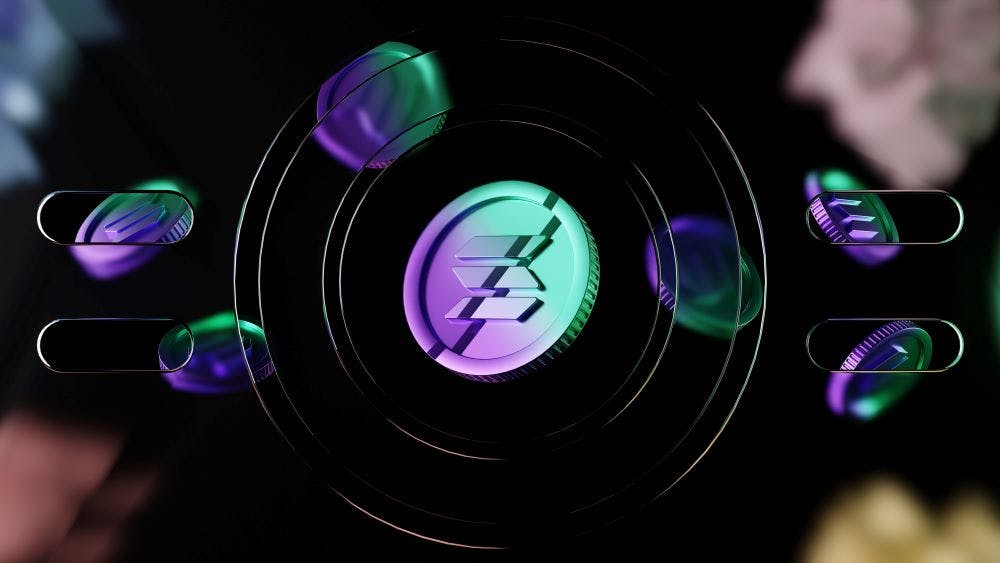Solana is a high-performance blockchain platform that provides fast and scalable solutions for decentralized applications (dApps) and cryptocurrencies. It achieves high transaction per second (TPS) rates and scalability through innovative technologies.
Let’s dive deep into its components and see how it differs from the leader Ethereum and other currencies:
Architecture and Consensus Mechanism
- Solana uses a unique architecture called the “Tower Byzantine Fault Tolerance” (TBFT). This consensus mechanism combines proof-of-stake (PoS) and proof-of-history (PoH) elements
- PoH is a crucial component of Solana’s architecture that provides a verifiable time source for the network. It establishes an immutable and sequential order of events, essential for efficient transaction processing and consensus.
- How is it achieved? PoH is achieved by generating cryptographic proofs for each historical event or transaction. These proofs serve as evidence that a particular event occurred at a specific point in time. The PoH mechanism operates independently of the consensus algorithm and acts as a global clock for the network

Clock Ticking
You might be wondering how one can achieve a global clock. Different nodes in the network would have slightly different timings due to factors such as network latency, clock synchronization, and processing speeds.
However, Solana’s Proof-Of-History mechanism addresses this issue and provides a consistent and verifiable time source across the network. Interesting, isn’t it? Okay, but tell me how it does that.
Here’s how it ensures trust in the timings:
- Leader-Generated Ticks: In Solana, a designated leader node generates ticks representing fixed time intervals. These ticks are broadcasted to the network and serve as a time reference. Note: Leaders are rotated using a set of rules
- Network-wide Tick Verification: Every node in the network receives and verifies the ticks generated by the leader. By independently verifying the tick intervals, nodes can ensure that the leader produces them at regular and expected intervals. But how does a node verify this?
- Receipt of Tick: The node receives the tick broadcasted by the leader. The tick contains information such as the tick’s timestamp and the cryptographic hash of the previous tick.
- Clock Synchronization: The node compares the received tick’s timestamp with its own internal clock. Clock synchronization mechanisms, such as the Network Time Protocol (NTP), can be used to ensure the node’s clock is reasonably synchronized with the network’s clock. This step helps the node determine if the received tick is within an acceptable time range.
- Validating timestamp Interval: Nodes expect ticks to be generated at regular intervals. The node checks if the time interval between the received tick and the previous tick aligns with the expected tick interval. If the tick interval deviates significantly from the expected interval, it may indicate an issue with the tick generation process.
- Hash Verification: Each tick contains a cryptographic hash computed from the previous tick’s hash. The node verifies the integrity of the tick by recomputing the hash from the previous tick it has stored and comparing it with the hash received in the current tick. If the computed hash matches the received hash, it confirms the integrity and continuity of the tick chain.
- Consensus Agreement: In TBFT (Tower Byzantine Fault Tolerance) consensus algorithm, multiple validators agree on the ticks and their order. Validators compare their received ticks and hash with other validators to ensure consensus. If a supermajority of validators agrees on a particular tick and its order, it is considered valid.
- Consensus on PoH Sequence:The PoH sequence, created by chaining the cryptographic hashes of each tick, is agreed upon by network validators using the Tower Byzantine Fault Tolerance (TBFT) consensus algorithm.
- Cryptographic Anchoring:The cryptographic hashes of the ticks create an immutable and tamper-proof chain. Any alteration to a previous tick would change subsequent tick hashes, providing cryptographic evidence of tampering. This anchoring mechanism ensures the integrity and immutability of the PoH sequence.
- Proof Verification:Validators can generate cryptographic proofs for the PoH sequence, indicating the events' order. By validating these proofs, validators can confirm the timing of specific events and transactions within the PoH sequence
The network validators, known as “replicas”, reach consensus using proof-of-stake principles, with a rotating set of validators chosen for each slot (a fixed time interval). This architecture enables high TPS rates and
Replication and Clustering
Solana leverages a " replication " technique to distribute transactions and state updates across the network. It divides the network into small subnets called “clusters”, each containing multiple validators. Solana archives high throughput by allowing parallel processing of transactions within a cluster. Additionally, the network can dynamically adjust the number of clusters based on demand, enhancing scalability.
But how will we have the main blockchain if each cluster operates independently of the other cluster? How will we know that this cluster is not acting maliciously?
Mechanisms are in place to ensure the integrity of the main blockchain and prevent malicious behavior.
- Consensus Mechanism: It utilized TBFT to achieve agreement on the order of transactions and events across clusters. Validators within each cluster participate in the consensus process to determine the global order of transactions.. The consensus process involves communication and agreement among validators, ensuring that each cluster contributes to forming a coherent and consistent blockchain.
- Cross-Cluster Communication: Although clusters operate independently, they are not completely isolated. Communication and information are shared between clusters to maintain consistency in the blockchain. Validators within each cluster share information, such as cryptographic proofs of events, with validators from other clusters to establish a unified view of the blockchain state

Proof
Proof-of-History (PoH)
The PoH mechanism generates cryptographic proof for each historical event on the network, establishing a reliable order of events. This eliminates the need for full consensus on every transaction, reducing the overall communication and computation requirements. PoH acts as a clock for the network, enabling efficient transaction processing and validation.
How does Proof-of-History (PoH) in Solana minimize the requirement for achieving full consensus on every transaction?Here’s how PoH achieves this:
- Immutable Time Sequencing: PoH generates a cryptographic proof for each historical event or tick, establishing an immutable and sequential order of events on the network. This allows validators to refer to the PoH sequence to determine the relative ordering of transactions and events
- Consensus on PoH: Validators in Solana’s network reaches a consensus on the order and validity of the PoH sequence rather than on every individual transaction. The PoH acts as a clock and provides a shared understanding of time across the network. Validators agree on the sequence of ticks and their order, enabling them to efficiently validate transactions and events without reaching full consensus on every single one.
- Efficient Validation: Rather than individually validating each transaction, validators verify the transactions’ inclusion within the PoH sequence, reducing the communication and computational overhead needed for consensus.
- Trust in PoH Sequence: As long as validators trust the integrity of the PoH sequence and its consensus, they can trust the order of events and transactions within that sequence. By agreeing on the PoH sequence, validators can efficiently process and validate transactions without waiting for consensus on every transaction.
Tower Consensus
Solana’s TBFT consensus mechanism ensures the network’s security and liveness by requiring a supermajority of replicas to agree on the order of transactions. This provides resistance against Byzantine faults while maintaining fast confirmation times. Let’s dive deep into it:
- Validator Set and Voting: Solana’s network consists of validators responsible for maintaining the network’s security and reaching consensus. Each validator has a voting weight, typically determined by the stake they hold in the network. The voting weight determines the influence of a validator in the consensus process.
- Slot and Leader Selection: Time in Solana is divided into discrete units called slots. For each slot, a leader is selected from the validator set. The leader is responsible for proposing a block of transactions and facilitating the consensus process for that slot.
- Leader Proposes a Block: The leader for a given slot proposes a block that contains a batch of transactions. The leader collects transactions from the network and creates a block proposal.
- Prevotes and Precommits: During the consensus process, validators participate in two voting stages: prevote and pre-commit. In the prevote stage, validators communicate their tentative preference for a particular block proposal. In the pre-commit stage, validators make a stronger commitment to a specific block proposal.
- Weighted Voting and Threshold: Validators’ voting power is determined by their voting weight. During both the prevote and pre-commit stages, validators cast their votes based on their preference for a particular block. A threshold is set for each stage, specifying the minimum total voting weight required to reach a consensus.
- Supermajority Agreement: Consensus is reached when a supermajority of validators agree on a block proposal. A supermajority of prevotes for a block proposal triggers the pre-commit stage in the prevote stage. Similarly, a supermajority of pre-commits for a block proposal finalizes the consensus decision.
- Finality and Block Confirmation: Once a block is finalized, it achieves a state of irreversibility and is confirmed as part of the blockchain history. Finalized blocks cannot be changed or altered, ensuring the integrity and immutability of the blockchain.
- Fork Resolution: Solana utilizes a “fork resolution” mechanism to determine the main chain in case of conflicting block proposals. Fork resolution resolves conflicts by considering the highest-voted blocks and validators’ stakes, ensuring the network converges to a single valid chain.
Advantages of Solana
- High Throughput: Solana’s architecture enables extremely high TPS, currently capable of handling thousands of transactions per second, making it suitable for high-performance applications.
- Scalability: Solana’s ability to dynamically adjust the number of clusters helps it scale with growing network demand.
- Low Latency: Solana achieves low confirmation times due to its efficient consensus mechanism and parallel transaction processing.
- Developer-Friendly: Solana provides a robust framework with a growing ecosystem of tools, libraries, and documentation, making it attractive for developers.
Disadvantages and Challenges
- Centralization Concerns: Solana’s current implementation relies on a relatively small number of validators, raising concerns about the potential centralization of power.
- Limited Adoption: While Solana has gained attention and popularity, it still faces competition from established protocols like Ethereum, which has larger developer communities and a wider range of dApps.
Solana Outage
The Solana ecosystem experienced a significant outage on September 14, 2021, which affected the network’s availability and led to disruptions in various dApps and services built on Solana. The outage was primarily caused by a combination of high network congestion and a bug in the network’s transaction processing.
During the outage, a surge in transaction activity resulted in many transactions being submitted to the network within a short period. This high demand for processing transactions increased network congestion and slowed block production.
Additionally, the bug in the transaction processing led to a cascading failure, where the network struggled to process transactions efficiently. As the backlog of pending transactions increased, it further exacerbated the congestion and degraded the network’s performance.
The Solana development team and community responded promptly to address the issue. They implemented measures to stabilize the network, optimize transaction processing, and improve the system's overall resilience. The Solana network resumed normal operation after implementing the necessary fixes and upgrades.
Thank you for taking the time to read my article
